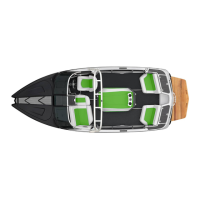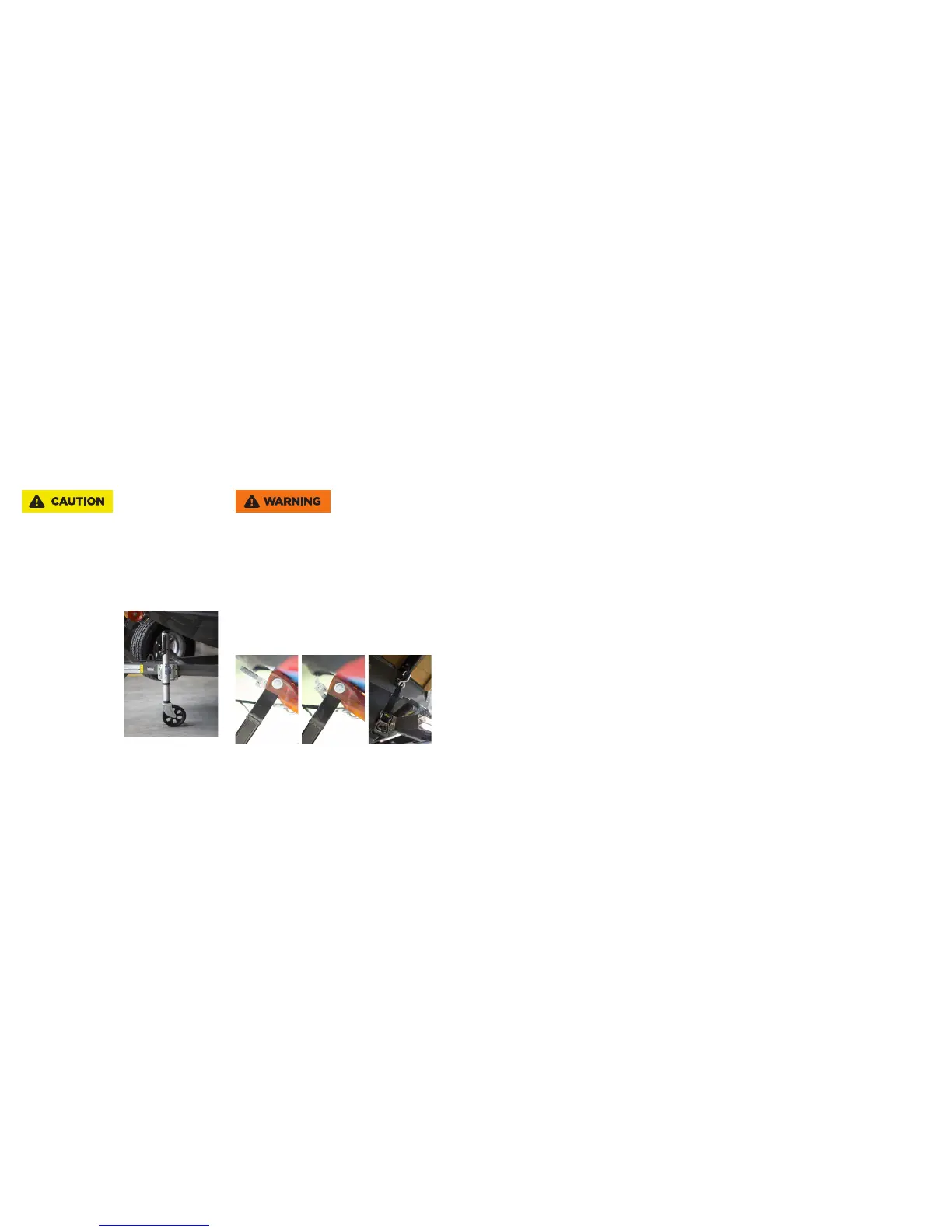2017 OWNERS MANUAL / 430
Ensuring that a MasterCraft boat will be held securely in place on
the trailer’s hull support (bunks), especially when towing, is ex-
tremely important. If the boat is not firmly and properly secured, the
boat can be damaged as it bounces against the hull supports.
MasterCraft oers the Ramp-N-Clamp system to simplify loading
and launching the boat from the trailer. To operate:
• Set the Ramp-N-Clamp handle to the down position so it can
catch the boat when loading onto the trailer.
• Lift the Ramp-N-Clamp handle to the up position to release boat
from the trailer.
• Do not lift the Ramp-N-Clamp handle until you are ready to re-
lease boat from the trailer.
Helpful Tips
For easier release on the ramp, put the boat in forward gear or keep
the winch strap tight while lifting the Ramp-N-Clamp handle.
Keeping the Ramp-N-Clamp cover and front of the boat waxed is
part of the proper, regular maintenance.
If the boat rocks back and forth on the trailer while towing, raise
the winch post uprights or add tie down straps to trailer to prevent
rocking. An ill-fitting trailer will cause wear that is not covered under
the warranty.
A winch strap must be used and be firmly tight while towing. This
prevents wear to the bow eye that is not covered under warranty.
Important: Do not use brake fluid drained from the brake system to
refill the master cylinder reservoir as such fluids contain contam-
inants from the system that may result in brake failure or costly
repairs.
Trailer Jack
MasterCraft recommends using the trailer jack to lift the coupling
of a loaded trailer from the hitch ball. Rotate the trailer jack to the
vertical position and engage the locking pin before placing a load on
the trailer jack.
Like any mechanical assembly,
the trailer jack requires main-
tenance to continue to function
properly. The drive gear and
the rack-and-pinion should be
greased, and the caster and
wheel bearings should be oiled
frequently.
Failure to swing up the trailer jack
and snap into towing position be-
fore towing may result in damage
to the trailer.
Also, it is very important to be sure that the transom of the Mas-
terCraft boat is resting fully and securely on the supports provided
at the rear end of the trailer, and that it remains in place when the
trailer is parked or underway.
Tie-down eyes have been added on both the bow and transom of
the boat and must be used while trailering. Buckles at the back of
the trailer must also be secured to the boat prior to towing.
Hitching Up
• Hitch only to the ball size marked on the coupler, which, for all
models is two inches (2”), except the X26 which is 2
5/16
”
• Be certain that the ball clamp captures the ball.
• Cross the safety cables under the coupling.
Allow only enough slack in the safety cables to permit tight turns
while towing. When hitching the trailer up, always observe each item
on the Trailer Checklist found in this Owner’s Manual. Hitching the
trailer to the tow vehicle may be performed by just one person, but it
is definitely easier with a second person to help guide.
Trailer Hitching Steps
1. Slowly back the tow vehicle as close as possible to the trailer. It’s
easier—and safer—than pulling the trailer to the car or truck.
2. Check to be sure the coupler locking device is released.
3. Raise the front end of the trailer with the trailer jack, position the
coupler directly over the hitch ball and lower the trailer with the
trailer jack until it is all the way down onto the hitch ball.
Failure to engage the locking pin may result in the collapse of the
jack stand, which could cause serious injury or death.
Always be certain that the feet of individuals operating the trailer
jack or in the vicinity of the trailer jack are clear when the jack
is lowered into position. A considerable amount of the trailer’s
weight, and that of the boat when it is aboard the trailer, can
be transferred through the trailer jack. This could cause very
painful injuries if feet are not clear of the jack when it is lowered.
Be certain that fingers and hands are clear when moving the
trailer jack because they can be pinched in the mechanism, again
resulting in injury.
Tie Downs

